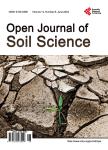Post Flooding Effect on Soil Quality in Nigeria: The Asaba, Onitsha Experience
Post Flooding Effect on Soil Quality in Nigeria: The Asaba, Onitsha Experience作者机构:Department of Chemistry Ambrose Ali University Ekpoma Edo State Nigeria Department of Chemistry Delta State University Abraka Delta State Nigeria Department of Chemistry Taraba State University Jalingo Taraba State Nigeria.
出 版 物:《Open Journal of Soil Science》 (土壤科学期刊(英文))
年 卷 期:2014年第4卷第2期
页 面:72-80页
学科分类:1002[医学-临床医学] 100214[医学-肿瘤学] 10[医学]
主 题:Flooding Asaba Farmland Onitsha Farmland Physicochemical Property Soil
摘 要:This study focuses on the post effect of flooding on soil quality parameters in agricultural farmlands in Nigeria. Soil samples were collected from farmland in Alihame Agbor, Ika South local government area of Delta state, Okwei in Asaba, Oshimil South local government area of Delta state and fegge in Onitsha South local government area of Anambra state. Farmlands in Asaba and Onitsha were used for the post flooding study, while farmland in Agbor served as control since it was not affected by flooding. Soil physicochemical parameters such as pH, electrical conductivity, total organic carbon, total organic matter, total nitrogen, total phosphorus, cation exchange capacity, moisture content and metals (Cd, Pb, Cu, Mn, Ni and K) which were used as index for assessing the effect of flooding on soil quality were analyzed using standard methods. Significant effect of flooding was observed on soil properties on the flood affected farmlands when compared to the control farmland, which was statistically justified at 95% confidence limit (p ≤ 0.05). There were considerable decreases ranging from 4% to 53% at p ≤ 0.05 in the values of pH, total organic carbon, total organic matter, total nitrogen, total phosphorus and cation exchange capacity on the flood affected farmlands when compared to the control farmland;except for electrical conductivity where an increase of 54% and 92% at the flood affected farmlands in Asaba and Onitsha respectively was observed when compared to the control. Higher moisture contents were also recorded of up to about 17% and 45% at the flood affected farmlands in Asaba and Onitsha respectively, when compared to the control. Reduced concentrations ranging from 25% to 49% of essential micronutrients such as Mn, Ni and K were observed on the flood affected farmlands, reflecting the negative impact of the flood. Undesirable effect of the flood was also observed in the flood affected farmlands when compared to the control farmland as increased concentratio



